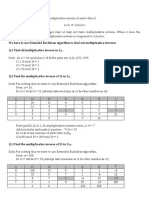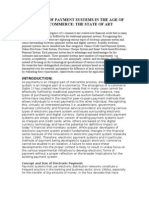Design and Implementation of Network Security Using Neural Network Architecture
Uploaded by
Journal of ComputingDesign and Implementation of Network Security Using Neural Network Architecture
Uploaded by
Journal of ComputingJOURNAL OF COMPUTING, VOLUME 4, ISSUE 8, AUGUST 2012, ISSN (Online) 2151-9617 https://sites.google.com/site/journalofcomputing WWW.JOURNALOFCOMPUTING.
ORG
115
Design and Implementation of Network Security using Neural Network Architecture
1
1
Inadyuti Dutt, 2Soumya Paul, 3Sudipto Chandra
3
Assistant Prof., Assoc. Prof., Dept. of Computer Application, B. P. Poddar Institute of Management & Technology, Affiliated to West Bengal University of Technology
MCA final year Dept. of Computer Application, B. P. Poddar Institute of Management & Technology, Affiliated to West Bengal University of Technology
Abstract: Over the last few years, secured transmission of data has been a major issue in data communication. This implementation mainly concerns about the security of confidential information and data transmission through Neural Network in order to provide confidentiality, authentication, integrity and non-repudiation of the messages. First, an encryption algorithm is developed and implemented to achieve the aforesaid purpose. It is basically a program that takes any plain text as input from the user and produces a cipher text which is sent to the source node of neural network. Now the cipher text is again encrypted and fragmented in successive layers of neural networks concept and finally all the fragments are collected and decrypted at destination node to get the cipher text which was input to the source node. Then the cipher text is decrypted to get original plain text.
Keywords: Neural Network (NN)
1. Introduction:
Network security consists of the provisions and policies to prevent and monitor unauthorized access, misuse, modification, or denial of a computer network and network-accessible resources. Network security involves the authorization of access to data in a network, which is controlled by the network administrator. Users choose or are assigned a password or other authenticating information that allows them access to information and programs within their authority. Network security covers a variety of computer networks, both public and private, that are used in everyday jobs conducting transactions and communications among businesses, government agencies and individuals. based on external or internal information that flows through the network during the learning phase. Modern neural networks are non-linear statistical data modeling tools. They are usually used to model complex relationships between inputs and outputs or to find patterns in data.
1.2 Outline of Remaining Section:
The paper is organized as follows: Section 2 states the problem and the security of files that contain certain confidential information. The detailed description of the proposed encryption decryption algorithms with illustration of examples are explained in section 3. Finally, the paper concludes in section 4.
2. Problem Statement
Encryption method follows as the first and the basic criteria in order to encrypt a plain text is to input a password because the key array is generated from this password. In symmetrickey cryptography, it is obvious that when a text is encrypted with a secret key, it is decrypted with the same key. The plain text is encrypted to produce cipher (cipher 0) using key array. The cipher 0 text is sent as input to the source node of neural network and the cipher get encrypted in successive layers and
1.1. Neural network:
A neural network consists of an interconnected group of artificial neurons, and it processes information using a connectionist approach to computation. In most cases an ANN is an adaptive system that changes its structure
2012 Journal of Computing Press, NY, USA, ISSN 2151-9617
JOURNAL OF COMPUTING, VOLUME 4, ISSUE 8, AUGUST 2012, ISSN (Online) 2151-9617 https://sites.google.com/site/journalofcomputing WWW.JOURNALOFCOMPUTING.ORG
116
decrypted at destination node to produce the initial cipher (cipher 0). The same key array is used in decryption to get back the actual text. So, decryption requires knowledge of the same key.
Send e1 to NODE N+1 of layer L+1 ELSE Step 4: Set e: = ASCII (cipher character) key[i]-w. Send e to Node N +2 of layer L+1 Step 5: Set i: = i+1. Step 6: Stop
Encryption: cipher 0 = encrypt (plaintext, key []) Encryption at layer l of neural network: cipher n= decrypt (cipher, key [], weight of node n ) Decryption at destination: cipher 0 = decrypt ( cipher n, key[] ,weight of destination) Decryption: Plaintext = decrypt (cipher 0, key [])
3.3 Proposed Decryption Heuristic Using Neural Network
Input: Encrypted Cipher text from layer L-1 Output: Decrypted Cipher Step 1: Start Step 2: Set weight w: =x, i=1 Step 3: if cipher character pos is Odd then Set d: = ASCII (encrypted cipher) -key[i]-w ELSE Step 4: Set d: = ASCII (encrypted cipher) +key[i] +w Step 5: Set i: = i+1 Step 6: Stop
3.4 Proposed Decryption Heuristic
Step 1: Start Step 2: Take all alphabet from A to Z in a matrix I (6X6). Step 3: Take a password Step 4: Reverse the row and column of the matrix I (6X6) according to the password to get matrix R (6X6). Step 5: Take the Decrypted text in a square matrix A Step 6: Reverse the Even column and Odd row of matrix A respectively Step 7: Decrypt each element of matrix A using position of elements of matrix I and R to generate plain text. Step 8: Stop
3. Proposed Algorithm 3.1. Proposed Encryption Heuristic
Input: Plain text is given. Output: Encrypted cipher text. Step 1: Start Step 2: Take all alphabet from A to Z in a matrix I (6X6). Step 3: Take a password Step 4: Reverse the row and column of the matrix I (6X6) according to the password to get the matrix R (6X6). Step 5: Take the plain text in a square matrix A Step 6: Reverse the Odd row and Even column of matrix A respectively. Step 7: Encrypt each element of matrix A using position of elements of matrix I and R. Step 8: Stop
3.5 Proposed Cryptographic Algorithm
Step 1: Start Step 2: Call Proposed Encryption Heuristic//Subsection 3.1 Step 3: Call Proposed Encryption Heuristic using Neural Network//Subsection 3.2 Step 4: Call Proposed Encryption Heuristic using Neural Network//Subsection 3.3 Step 5: Call Proposed Decryption Heuristic Step 6: Stop
3.2 Proposed Encryption Heuristic Using Neural Network
Input: Cipher text obtained in initial encryption, List of keys key [] from password Output: Successively encrypted Cipher text. Step 1: Start Step 2: Set weight w: = x, i: =1 Step 3: IF cipher character pos is Odd then Set e: = ASCII (cipher character) +key[i] +w
3.6 Illustration of Proposed Algorithm with example A. Encryption
2012 Journal of Computing Press, NY, USA, ISSN 2151-9617
JOURNAL OF COMPUTING, VOLUME 4, ISSUE 8, AUGUST 2012, ISSN (Online) 2151-9617 https://sites.google.com/site/journalofcomputing WWW.JOURNALOFCOMPUTING.ORG
117
Sep 1: We take @ = 0 and [A-Z] = [1-26] as follows: 0 @ 1 A 2 B 3 C 4 D 5 E 6 F 7 G 8 H 9 I 10 J 11 K 12 L 13 M 14 N 15 O 16 P 17 Q 18 R 19 S 20 T 21 U 22 V 23 W 24 X 25 Y 26 Z
Now we take an Initial Matrix I (6x6):
0 1 2 3 4 5 0 @ K L R X 1 A J M S Y 2 B I N T Z 3 U O H C 4 D G P V 5 E F Q W
STEP 2: We take a password: HONEYBEE
H 8 18 O 15 11 N 14 12 E 5 21 Y 25 1 B 2 24 E 5 21 E 5 21
(pos) (26pos)
Continuing in similar way, we finally get the following:
0 1 2 3 4 5 0 Z E Q K @ 1 A J P V Y 2 X T H C B 3 U O N I 4 D G M S 5 W L F R
So, We take Key[ ]={18,11,12,21,1,24,21,21} STEP 3: We change our Initial Matrix I (6 X6) into a new Reference Matrix R (6X6) using position of element of password (pos):
This is our Reference Matrix R (6X6) STEP 4: Let us take a plain text which is required to be encrypted. Plain text: THE SKY IS BLUE The text consists of 15 characters. So, a (4X4) matrix would be sufficient to accommodate all characters as follows:
0 T S I L 1 H K S U 2 E Y @ E 3 @ @ B @
The 1st elemen t in password array is H. So, we reverse the Row that consists of H and we get the following:
0 @ F L R X 1 A G M S Y 2 B H N T Z 3 C I O U 4 D J P V 5 E K Q W
0 1 2 3 4 5
0 0 6 12 18 24
1 1 7 13 19 25
2 2 8 14 20 26
3 3 9 15 21
4 4 10 16 22
5 5 11 17 23
0 1 2 3 4 5
0 1 2 3
0 1 2 3
@ K L R X A J M S Y B I N T Z C H O U D G P V E F Q W
0 20 19 9 12
1 8 11 19 21
2 5 25 0 5
3 0 0 2 0
0 1 2 3 4 5
STEP 5: Now, we take a matrix B (4X4) where B (i, j) =26-A (i, j). Matrix (B) =>
0 1 2 3 0 6 7 17 14 1 18 15 7 5 2 21 1 26 21 3 26 26 24 26
The 2nd element in password array is O. So, we reverse the Column that consists of O and we get the following:
2012 Journal of Computing Press, NY, USA, ISSN 2151-9617
JOURNAL OF COMPUTING, VOLUME 4, ISSUE 8, AUGUST 2012, ISSN (Online) 2151-9617 https://sites.google.com/site/journalofcomputing WWW.JOURNALOFCOMPUTING.ORG
118
G
0 F G Q N 1 R O G E 2 U A Z U 3 Z Z X Z
0 1 2 3
STEP 6: Now we reverse each ODD Row of Matrix B
0 26 7 24 14 1 21 15 26 5 2 18 1 7 21 3 6 26 17 26
0 1 2 3
0 1 2 3
0 Z G X N
1 U O Z E
2 R A G U
3 F Z Q Z
STEP 7: Now we reverse each EVEN Column of Matrix B
0 26 7 24 14 1 5 26 15 21 2 18 1 7 21 3 26 17 26 6
=> 7 => I (1, 1) => R (1, 1) => J Z => 26 => I (4, 2) => R (4, 2) => B A => 1 => I (0, 1) => R (0, 1) => A Q => 17 => I (2, 5) => R (2, 5) => F X => 24 => I (4, 0) => R (4, 0) => @ O => 15 => I (2, 3) => R (2, 3) => N G => 7 => I (1, 1) => R (1, 1) => J Z => 26 => I (4, 2) => R (4, 2) => B N => 14 => I (2, 2) => R (2, 2) => H U => 21 => I (3, 3) => R (3, 3) => I U => 21 => I (3, 3) => R (3, 3) => I F => 6 => I (1, 0) => R (1, 0) => E So, the text now becomes: BWKBJBAF@NJBHIIE i.e. BWKBJBAF NJBHIIE which is to be send through neural network.
0 1 2 3
B. Neural Network
Text received at Node 1: BWKBJBAF@NJBHIIE Node 1: Weight (w) =1 Read the 1st character: B position (1st position)] ASCII (B) =67 Weight (w) =1 1) Key [0] =18 ASCII (66-18-
[B is in Odd
0 1 2 3
0 Z G X N
1 E Z O U
2 R A G U
3 Z Q Z F
The sentence becomes: ZERZGZAQXOGZNUUF STEP 8: Now, we encrypt the above text taking the position of each character in the text with respect to our Initial Matrix I (6 X6) and corresponding Reference matrix R (6X6) as shown below: Z => 26 => I (4, 2) => R (4, 2) => B E => 5 => I (0.5) => R (0, 5) => W R => 18 => I (3, 0) => R (3, 0) => K Z => 26 => I (4, 2) => R (4, 2) => B
ASCII (47) / Node 3
Node 1: Weight (w) =1 Read the 2nd character: W [W is in Even position (2nd position)] ASCII (w) =87 Weight (w) =1 Key [1] =11 ASCII (87+11+1) ASCII (99) Node 2 c
2012 Journal of Computing Press, NY, USA, ISSN 2151-9617
JOURNAL OF COMPUTING, VOLUME 4, ISSUE 8, AUGUST 2012, ISSN (Online) 2151-9617 https://sites.google.com/site/journalofcomputing WWW.JOURNALOFCOMPUTING.ORG
119
And so on.
C. Decryption
STEP 1: We take @ =0 and [A-Z] = [1-26] as follows: 0 @ 10 J 20 T 1 A 11 K 21 U 2 B 12 L 22 V 3 C 13 M 23 W 4 D 14 N 24 X 5 E 15 O 25 Y 6 F 16 P 26 Z 7 G 17 Q 8 H 18 R 9 I 19 S
0 1 2 3 4 5
0 Z E Q K @
1 A J P V Y
2 X T H C B
3 U O N I
4 D G M S
5 W L F R
STEP 4: Text received at Node 6(Destination Node): BWKBJBAF@NJBHIIE Now, we decrypt the above text taking the position of each character in the text with respect to our Initial Matrix I (6 X6) and corresponding Reference matrix R (6X6) as shown below: B => => => => => => => => => => => => => => => => => => => => => => => => => => => => => => => => R (4, 2) => 26 => R (0, 5) 5 R (3, 0) 18 R (4, 2) 26 R (1, 1) 7 R (4, 2) 26 R (0, 1) 1 R (2, 5) 17 R (4, 0) 24 R (2, 3) 15 R (1, 1) 7 R (4, 2) 26 R (2, 2) 14 R (3, 3) 21 R (3, 3) 21 R (1, 0) 6 => => => => => => => => => => => => => => => => => => => => => => => => => => => => => => I (4, 2) Z I (0.5) E I (3, 0) R I (4, 2) Z I (1, 1) G I (4, 2) Z I (0, 1) A I (2, 5) Q I (4, 0) X I (2, 3) O I (1, 1) G I (4, 2) Z I (2, 2) N I (3, 3) U I (3, 3) U I (1, 0) F
Now we take an Initial Matrix I (6x6):
W
0 1 2 3 4 5 0 0 6 12 18 24 1 1 7 13 19 25 2 2 8 14 20 26 3 3 9 15 21 4 4 10 16 22 5 5 11 17 23
Now w
K B J B
STEP 2: We take a password: HONEYBEE H 8 O 15 N 14 E 5 Y 25 B 2 E 5 E 5
A F @
(pos)
STEP 3: We change our Initial Matrix I (6 X6) to generate a new Reference Matrix R (6X6) using position of element of password (pos) as shown in Step 3 of Encryption.
N J B H
0 1 2 3 4 5
0 @ F L R X
1 A G M S Y
2 B H N T Z
3 C I O U
4 D J P V
5 E K Q W
I I E
Taking the characters in Matrix a (4 X 4)
Reference Matrix R (6X6):
0 1 2 3 0 Z G X N 1 E Z O U 2 R A G U 3 Z Q Z F
2012 Journal of Computing Press, NY, USA, ISSN 2151-9617
JOURNAL OF COMPUTING, VOLUME 4, ISSUE 8, AUGUST 2012, ISSN (Online) 2151-9617 https://sites.google.com/site/journalofcomputing WWW.JOURNALOFCOMPUTING.ORG
120
0 1 2 3
0 26 7 24 14
1 5 26 15 21
2 18 1 7 21
3 26 17 26 6
STEP 5: Now we reverse each EVEN Column of Matrix A
0 Z G X N 1 U O Z E 2 R A G U 3 F Z Q Z
public and ii) Private Key, which is kept secret. Any message encrypted using private key can be decrypted using public key or vice versa. So, the message gets decrypted when it is encrypted by only the authenticated person who knows the private key.
5. References: Books:
1. Cryptography and Network Security, Third Edition, by William Stallings. Cryptography And Network Security (Sie), By Forouzan. An Introduction to Neural Networks, by Kevin Gurney, Kevin N. Gurney.
0 1 2 3
0 1 2 3
0 26 7 24 14
1 21 15 26 5
2 18 1 7 21
3 6 26 17 26
2. 3.
STEP 6: Now we reverse each ODD Row of Matrix A
0 F G Q N 1 R O G E 2 U A Z U 3 Z Z X Z
0 1 2 3
0 1 2 3
0 6 7 17 14
1 18 15 7 5
2 21 1 26 21
3 26 26 24 26
STEP 7: Now, we take a matrix B (4X4) where B (i, j) =26-A (i, j)
0 1 2 3 0 20 19 9 12 0 T S I L 1 8 11 19 21 1 H K S U 2 5 25 0 5 2 E Y @ E 3 0 0 2 0 3 @ @ B @
0 1 2 3
So, finally the decrypted text: THE SKY IS BLUE.
4. Conclusion:
Implementation of Cryptographic Algorithm (encryption and decryption Schemes) using asymmetric keys contains two keys: i) Public Key, which is known to
2012 Journal of Computing Press, NY, USA, ISSN 2151-9617
You might also like
- Cryptography & Network Security Lab: Paper Code (Etit-455)No ratings yetCryptography & Network Security Lab: Paper Code (Etit-455)70 pages
- Electrical Properties of Materials and Applications: Applied Physics For CSE StreamNo ratings yetElectrical Properties of Materials and Applications: Applied Physics For CSE Stream17 pages
- Project:-4 Newton'S Forward and Backward Difference Interpolation FormulaNo ratings yetProject:-4 Newton'S Forward and Backward Difference Interpolation Formula7 pages
- Electrical Analogies of Mechanical Systems PDFNo ratings yetElectrical Analogies of Mechanical Systems PDF6 pages
- Cohort 6 AICTE Registrtion and Internship Aplly Process DocumentNo ratings yetCohort 6 AICTE Registrtion and Internship Aplly Process Document43 pages
- SS ZG568 EC 2M SECOND SEM 2020 2021 Solution 1617600765956No ratings yetSS ZG568 EC 2M SECOND SEM 2020 2021 Solution 16176007659569 pages
- The Rabin-Karp Algorithm: String MatchingNo ratings yetThe Rabin-Karp Algorithm: String Matching18 pages
- Instant download Discrete Mathematics 5th Edition China Reprint Edition Dossey pdf all chapter100% (1)Instant download Discrete Mathematics 5th Edition China Reprint Edition Dossey pdf all chapter77 pages
- Python Progr Module 3 - 6th EC by 21EC643No ratings yetPython Progr Module 3 - 6th EC by 21EC64324 pages
- Internship Report: Praveen Kumar N 1PE15EC106No ratings yetInternship Report: Praveen Kumar N 1PE15EC10646 pages
- Principles of Database and Knowledge Base Systems Volume 1 1 PDFNo ratings yetPrinciples of Database and Knowledge Base Systems Volume 1 1 PDF654 pages
- Binary To Gray: B) Write A Behavioral VHDL Code Description To Implement Octal To Binary Encoder100% (1)Binary To Gray: B) Write A Behavioral VHDL Code Description To Implement Octal To Binary Encoder2 pages
- Unit 4 Cryptographic Hash Functions and Digital SignatureNo ratings yetUnit 4 Cryptographic Hash Functions and Digital Signature118 pages
- Bit Plane Slicing and Bit Plane CompressionNo ratings yetBit Plane Slicing and Bit Plane Compression5 pages
- Xavier Institute of Engineering: Lab ManualNo ratings yetXavier Institute of Engineering: Lab Manual55 pages
- Computer-graphics-Samit Bhattacharya-Department of Computer Science Engineering-Oxford Press-2015 eNo ratings yetComputer-graphics-Samit Bhattacharya-Department of Computer Science Engineering-Oxford Press-2015 e180 pages
- BCA603T Cryptography and Network Security: Unit - I ContentsNo ratings yetBCA603T Cryptography and Network Security: Unit - I Contents42 pages
- Simulation Modeling Lab Report Ankit Pangeni 1No ratings yetSimulation Modeling Lab Report Ankit Pangeni 118 pages
- Cryptography Using Artificial Neural NetworkNo ratings yetCryptography Using Artificial Neural Network18 pages
- Multiple Text Cryptanalysis by Using Matrix and Logical OperationsNo ratings yetMultiple Text Cryptanalysis by Using Matrix and Logical Operations3 pages
- Hybrid Network Coding Peer-to-Peer Content DistributionNo ratings yetHybrid Network Coding Peer-to-Peer Content Distribution10 pages
- Business Process: The Model and The RealityNo ratings yetBusiness Process: The Model and The Reality4 pages
- Product Lifecycle Management Advantages and ApproachNo ratings yetProduct Lifecycle Management Advantages and Approach4 pages
- Decision Support Model For Selection of Location Urban Green Public Open Space100% (1)Decision Support Model For Selection of Location Urban Green Public Open Space6 pages
- K-Means Clustering and Affinity Clustering Based On Heterogeneous Transfer LearningNo ratings yetK-Means Clustering and Affinity Clustering Based On Heterogeneous Transfer Learning7 pages
- Energy Efficient Routing Protocol Using Local Mobile Agent For Large Scale WSNsNo ratings yetEnergy Efficient Routing Protocol Using Local Mobile Agent For Large Scale WSNs6 pages
- Impact of Facebook Usage On The Academic Grades: A Case Study100% (1)Impact of Facebook Usage On The Academic Grades: A Case Study5 pages
- Hiding Image in Image by Five Modulus Method For Image Steganography100% (1)Hiding Image in Image by Five Modulus Method For Image Steganography5 pages
- Cloud Computing: Deployment Issues For The Enterprise SystemsNo ratings yetCloud Computing: Deployment Issues For The Enterprise Systems5 pages
- Private Federated Learning On Vertically Partitioned Data Via Entity Resolution and Additively Homomorphic EncryptionNo ratings yetPrivate Federated Learning On Vertically Partitioned Data Via Entity Resolution and Additively Homomorphic Encryption60 pages
- 20ITPC701 Cryptography and Network SecurityNo ratings yet20ITPC701 Cryptography and Network Security1 page
- E-Governance Public Key Infrastructure (PKI) Model: International Journal of Electronic Governance January 2013No ratings yetE-Governance Public Key Infrastructure (PKI) Model: International Journal of Electronic Governance January 201311 pages
- Emergence of Payment Systems in The Age of Electronic Commerce: The State of ArtNo ratings yetEmergence of Payment Systems in The Age of Electronic Commerce: The State of Art6 pages
- Efficient Regular Language Search For Secure Cloud StorageNo ratings yetEfficient Regular Language Search For Secure Cloud Storage14 pages
- Cryptography and Network Security 2022 Beu Pyq SolutionNo ratings yetCryptography and Network Security 2022 Beu Pyq Solution21 pages
- Enhanced Diffie-Hellman Algorithm For Reliable KeyNo ratings yetEnhanced Diffie-Hellman Algorithm For Reliable Key9 pages
- Digital Signatures: CCA Controller of Certifying AuthoritiesNo ratings yetDigital Signatures: CCA Controller of Certifying Authorities18 pages
- Ebook Ebook PDF Computer Security Principles and Practice 4Th Edition All Chapter PDF Docx Kindle100% (34)Ebook Ebook PDF Computer Security Principles and Practice 4Th Edition All Chapter PDF Docx Kindle41 pages
- Information Technology Act 2000: Submitted ToNo ratings yetInformation Technology Act 2000: Submitted To27 pages
- 4.4.3 Lab Use Classic and Modern Encryption Algorithms Answer KeyNo ratings yet4.4.3 Lab Use Classic and Modern Encryption Algorithms Answer Key4 pages
- Database Security Issues: Reading: CB, CH 19No ratings yetDatabase Security Issues: Reading: CB, CH 1913 pages




































































































